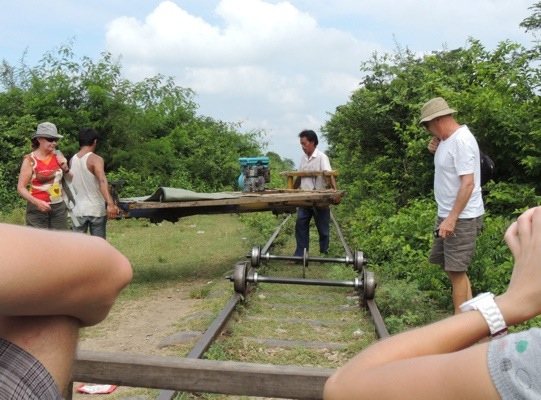Mr Blue was the tuk-tuk driver, who despite charging an exorbitant amount when I got off the bus in Battambang to the hotel, I paid to take me on a drive around the countryside the next day, forgetting to bargain for a price again!!
First we went to the bamboo train, this is only a tourist attraction but run along the track that used to be the main line from Thailand to Phnom Penh. It consists of a bamboo palette resting on the axels of a set of small train wheels, and is driven by a diesel motor. So you’re sitting fairly low to the ground where it is easy to see the rails , which are neither smooth nor parallel. The tracks runs ( thankfully) in a straight line for about 10 k through some villages, and flat flat countryside, to a village where there are brick kilns. Three beautifully built kilns, fuelled by rice husks.
What do you do when a train is coming in the opposite direction? Simple, passengers get off and your train is dismantled, two or more trains going in one direction, win over a single train in the other direction.
The trip round the countryside was very beautiful. Very few of the old wooden houses left. Here, when you do well and get rich, you build a new house out of modern non sustainable materials. Mr Blue thought the English were mad, when I explained it is the opposite and we aspire to a 300 year old house. I saw a village on the river where the exclusive business is drying fish, palette after palette of what looked like kippers lying in the sun to dry, some fish are smoked and they also make fish paste in the village, which goes into a great many dishes for flavour. It involves leaving fish to ferment for about three months, ( maybe I heard him wrong) and then doing various things to it. To my surprise it didn’t smell much. I must be getting acclimatised!
There were other industries, still done in the old way, making rice paper that is used for wrapping spring rolls, weaving, and drying thin strips on banana, 3 kilos can be sold to the shops for $1, that’s a lot of bananas and work.
I visited a temple that is now closed as it had been used by the Khmer Rouge, as a detention and torture centre, before slaughtering people, men, women children and babies. But I didn’t want to visit the caves that they threw people into, dead or alive, it didn’t matter to them. It seemed appropriate that it was Remembrance Day, these horrors should never be forgotten either.
The return journey to Siem Reap was on the boat, this was long and crowded , but included a few local people who had obviously been to Battambang to stock up on the goods that the shops in the local villages don’t have. The journey was along a river where there were lots of fishermen in their little dug out boats, and our boat weaved between them, so as not to get tangled in their nets( their livelihood). We then travelled along the top end of Tonle Sap lake (claimed by the Cambodians to be the largest lake in South East Asia) where there are many floating villages. The stronger houses are on stilts but the poorer ones are built on bamboo rafts. So every time a boat with its huge wake goes by their house rocks.
Before leaving Siem Reap , I will tell you a little about the school. Lunch break finished now, back to work!

